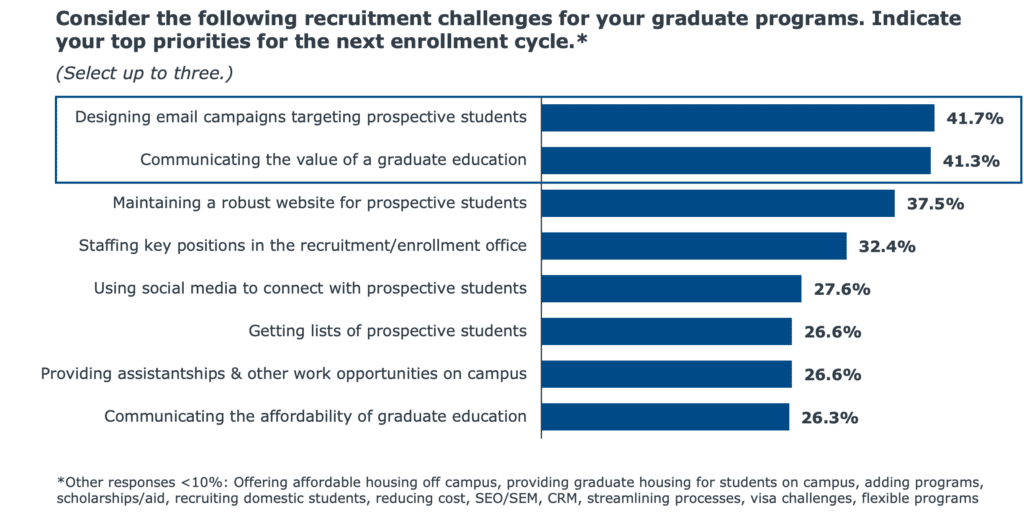How graduate enrollment leaders are keeping up with changing recruitment expectations
In my recent conversations with graduate enrollment leaders, the changing demographics of prospective students has become a frequent topic of interest – and for good reason. Next year, Millennials will account for 49% of adult learners, and Gen Z will account for 31%. However, by 2031, only 30% of adult learners will be Millennials, while Gen Z will account for a full 60%.

In our third survey with NAGAP, we asked graduate enrollment leaders about their experiences with recruitment. Here are three trends that our research demonstrated about graduate recruitment tactics.
1. Almost Half of Graduate Enrollment Leaders Want to Improve Their Email Campaigns
Of all the recruitment challenges that graduate leaders face, “designing email campaigns that target prospective students” is their highest priority. This finding isn’t surprising, given that today’s busy graduate and adult learners are spending less and less time reading the emails they open. Couple this with the fact that adults are commonly time-constrained due to competing work, family, and life responsibilities, and it’s easy to see why emails that quickly engage the recipient are critical.

In addition to being succinct, sophisticated, and multi modal, the most effective email campaigns are intent-based rather than time-based, like traditional drip campaigns. Demographic information and behavioral data gathered on prospective students should be used to ensure messaging is unique and tailored.
READ OUR TIPS ON WAYS TO IMPROVE YOUR EMAILS TO BETTER REACH BUSY ADULT LEARNERS
2. The Impact Recruitment Activities Have on Enrollment Can Vary by Modality
Graduate enrollment leaders revealed that events provided the best enrollment outcomes for graduate and professional schools. However, as may be expected, events were especially effective for in-person programs (39.1%) compared to hybrid (22.5%) and online programs (21.4%). Other high performing activities for in-person program included referrals from alumni and emails.
Survey respondents who work in a hybrid or online setting identified a wide, but slightly different, range of recruitment activities that had a big impact on enrollments. In addition to events, enrollment leaders reported that emails, web inquiries, and SEO/SEM activities had the most significant impact on enrollment. This success with a range of sources aligns with findings from our recent survey of graduate and adult learners, in which only 11% had first heard of their program via direct recruitment marketing.

LISTEN TO OUR PODCAST TO LEARN FOUR WAYS TO ENGAGE STEALTH SHOPPERS
3. Rapid Response Is Now Tables Stakes
Ninety-one percent of institutions are responding to information requests through emails within two days, as well as 89% of phone requests and 84% of web requests. If your team is not following up with inquiries/requests within this two-day timeframe, your program will have more difficulty making an impression in the minds of busy and distracted prospective learners.

Despite the quick turnaround, it is noteworthy that smaller schools are able to respond to students’ requests/inquiries more quickly than larger schools. For email inquiries, for example, 57.1% of schools with fewer than 1,000 graduate students responded on the same day, compared to 43.6% of schools with enrollment between 1,000 and 3,200, and just 25.6% of schools with more than 3,200 students. Though it may be more difficult for programs with a larger number of inquiries to respond in a timely manner, it is of the utmost importance in order to be competitive.
TAKE OUR SELF-ASSESSMENT TO LEARN THE BEST OPPORTUNITIES TO IMPROVE YOUR RECRUITMENT STRATEGY
Our research has found that graduate and adult learners are becoming increasingly difficult to recruit, and this will only continue as Gen Z becomes a larger portion of the prospect pool. To ensure the long-term health of your graduate programs, your recruitment tactics will need to speak to changing demographics and the corresponding changes in expectations of prospective students.

More Blogs

4 questions domestic students will ask before applying to your graduate program

When Grad PLUS disappears: What 8,000+ grad students said about paying for school
